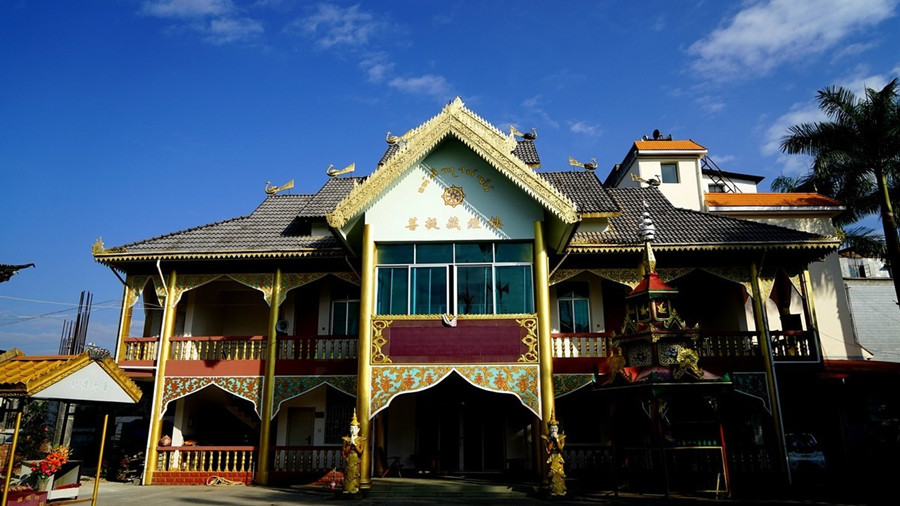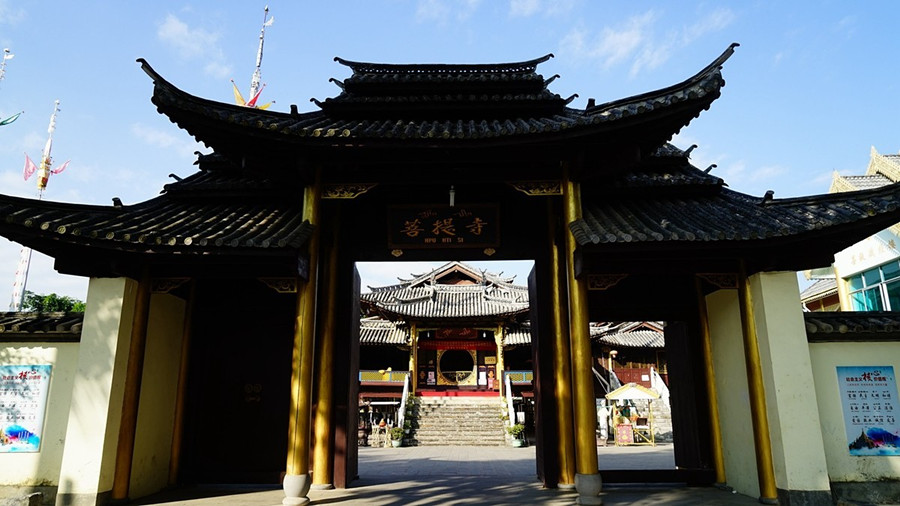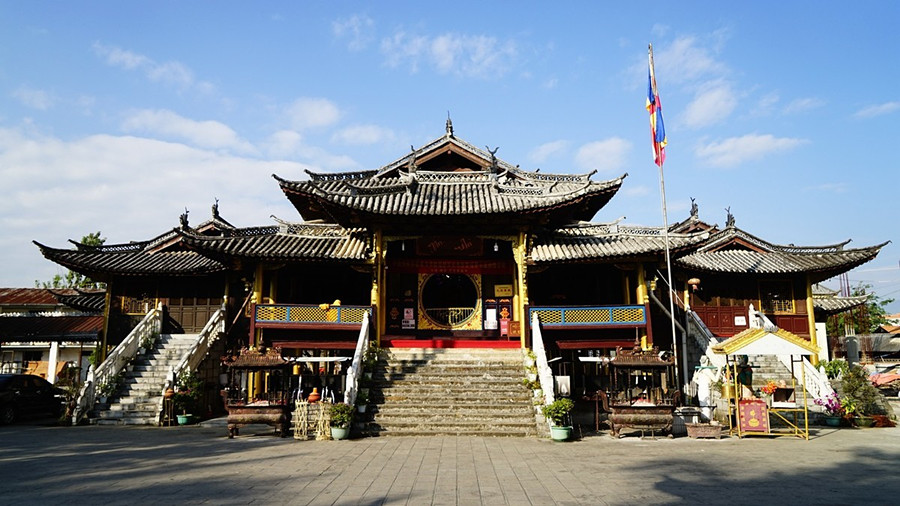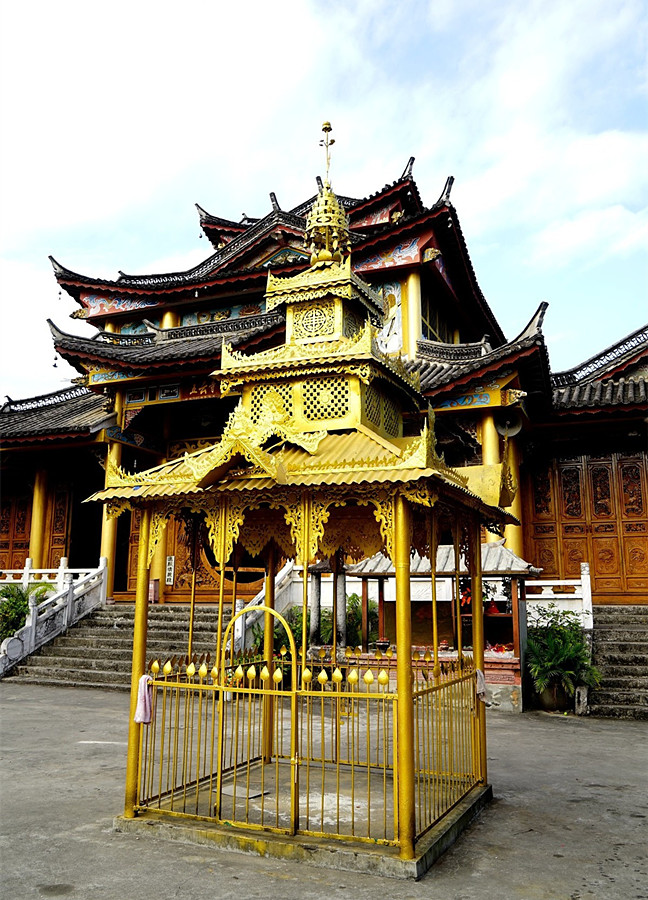
Bodhi Temple in Mangshi City, Dehong
Chinese Name:芒市菩提寺
English Name: Bodhi Temple in Mangshi City, Dehong
Bodhi Temple is recorded that the Temple was built in the year of Kangxi 16 in Qing Dynasty. At that time, the eldest son of Chief of Mangshi gave up his official position, shaved his head and became a monk; later he built a temple. Before the temple stood a big bodhi tree; so the temple was called Bodhi Temple. In the following 300 years, the Temple had gone through repeated chaos caused by wars and suffered a lot. It has been repaired for many times; till now, except for the roof built in the style of Han nationality, the whole building has a style of Dai.
The temple is not very big and covers an area of only 3,600 square meters. What is important is that there are in the temple all kinds of artistic treasures of Dai people from different historical stages during these hundreds of years like frescoes, paper-cuts and thousands of columns of lections.
The pair of stone carving animals in front of the main hall are a kind of magic animals in Burmese legends which are called “Gaduo” whose job is to guard the main hall of the Temple. Bodhi Temple is not only a place for the monks to patter and for the followers to worship, but also a precious deposit of traditional arts of Dai people.
After repairing and painting, the main hall of Bodhi Temple becomes more dignified. Every time when it is 8th, 15th, 23th, 30th in every lunar year, the followers of Buddhism from neighbouring villages would gather here to worship with fresh flowers and offerings. The Temple is quiet famous in Burma and in southeast Asia.






‣‣‣The introduction to Mangshi
Admission Fee:¥0
Attraction Transportation:
1.By bus Take bus from Xibu Bus Station in Kunming to Mangshi
2.By Air Changshui Airport in Kunming to Mangshi Airport Bodhi Temple is in the downtown, you can take a taxi when you arrive in Mangshi County.
Attraction Travel Tips: 1. carpet is put on the floor in the big palace, so take off your hats and shoes.
2. to show respect, please don’t take photos of figures of Buddha in the palace.
菩提寺,位于云南省德宏州潞西市芒市镇中心,是芒市地区现存较好的一座佛寺。粉墙绿瓦,层楼叠阁,斗拱飞檐,雕梁画栋,面对连绵伟岸的青山,背靠悠悠的芒市河,与风格独特的傣家竹楼、风光绮丽的亚热带景色相映成趣。
寺庙简介
菩提寺,位于云南省德宏州潞西市芒市镇中心,是芒市地区现存较好的一座佛寺。粉墙绿瓦,层楼叠阁,斗拱飞檐,雕梁画栋,面对连绵伟岸的青山,背靠悠悠的芒市河,与风格独特的傣家竹楼、风光绮丽的亚热带景色相映成趣。菩提寺初建于康熙十六年(一六六七年),因寺前有一株茂盛的菩提树,故得名。傣语称之为「奘桐」,意为宝石寺。
建筑特色
菩提寺是宫殿瓦顶式的木架楼房,属楼奘无塔寺,坐西向东。寺院占地三千六百平方米,其中寺基座占地一千平方米,寺高十四米,佛殿由屋架、屋脊、殿尖三部分组成。屋架以木结构为主体,十二根通天大柱拔地而起,穿过楼板直抵梁架,组成中堂顶架的本部(即正殿),两侧略小的木柱承接副梁构成四周的偏厦,使殿堂更加宽敞。整个殿内共有五十三棵木柱支撑,楼下中空,离地约两米。月圆形的正门向着东方(据传释迦牟尼修炼成佛是面东盘坐),正门的南北两边为侧门。外沿镶板壁,木料材考究,结构严密。大殿屋脊为上小下大的重檐建筑,歇山式。屋顶的举折及屋角出翘形如飞鸟展翼的重檐坡面各部分曲线流畅,造型优美,屋脊、檐面、翘角等均有装饰。傣族、汉族的歇山式屋顶与杆栏式木结构巧妙地结合起来,又融合从缅甸引进的黄铜镂空、缨络垂吊工艺,光艳夺目的「提奘」(小塔)悬于屋脊正中。
殿前台阶两旁,一对「嘎朵」(缅语传说中一种奇兽)雄姿勃勃,陡添几分庄严静穆气氛。佛殿正中,约三米高的释迦牟尼佛像端坐于莲台上。佛像流金溢彩,形体匀称和谐,表情生动细腻,面带慈祥的微笑,体态端庄。佛祖的两侧佛龛内,供有数十尊造型逼真,表情各异的佛像。其中有中国佛协一九五六年、一九九○年先后赠送的大小铜佛各一尊,极为珍贵。
与其它佛寺不同的是,菩提寺佛祖像前的左右两侧,迎门站着一对似真人般大小的塑像。左边的女像各「木林灭黑娜」(傣语传说中的护法神)。右边男塑像各「鱼说纵」,傣族上层男士打扮。两塑像均出身民间艺人之手,具有浓厚的民族特色。
历经三百多年菩提寺,珍藏着许多傣族不同时期的艺术珍品,有灿烂夺目的壁画,种类繁多的剪纸,内容丰富的万卷经书。「文革」前还存有清帝雍正所赐「佛光普照」巨匾。
寺庙活动
菩提寺既是台心,也是各族信众的文化娱乐场所。一年中该寺主要有三次大的活动,一是春节,各族信众身着艳丽服装进寺参观娱乐,观看傣戏,共庆佳节。中缅两国僧人彼此往来,取经念佛。二是欢度傣族、德昂族民间最盛大的传统节日--泼水节。芒市镇附近村寨的泼水节仪式就在此举行。节日伊始,窈窕的傣族少女虔诚地向佛祖献上鲜花、贡品,院内的人工飞龙,口喷银水,上下翻腾;顿时,水花、鼓声、铃声、歌声、欢笑声交融,犹如诗的王国,花的海洋。三是赶躲节,纪念佛祖受难,每值傣历九月十五日至十二月(阳历七月十月)这三个月中,教民禁止婚娶,忌食肉类,隔五日祈祷,供佛三天,祈求让佛祖平安渡过难关。
寺庙历史
在历史上,菩提寺曾几经兵燹破坏而修复。一九四二年,日军飞机轰炸芒市,该寺遭到严重破坏,使得名树(即菩提树)被毁;一九五○年当地信众在上舞狮朝贺时,不幸失火,寺院化为灰烬。一九五三年当地信众集资助开始重建,中国佛教协从北京送来一尊高大的赤脚佛像。一九五六年州政府拔专款装修寺院,从千里迢迢的京城迎来了「佛牙」,盛况空前的「佛牙摆」,震动中外。一九六六年因「文革」又遭厄运,寺毁僧散,一九七八年才再度迎得新生。修复后的菩提寺,殿堂宽敞明亮,雕梁画栋,巨形佛像,熠熠生辉。飞檐翘角上悬挂铁铃在微风吹拂下,发出轻柔悦耳的叮当声。冬日时节,晨雾笼罩佛寺,寺内飘出缕缕青烟,远远望去,古刹时隐时现,如梦如幻。
寺庙住持
菩提寺著名住持有召果里亚、伍汉地亚。现任住持伍俄达,三十馀岁,云南省潞西市人,兼任德宏州佛教协会副会长。现任监院方正午,云南省潞西市人,兼任德宏州佛教协会常务理事。
















